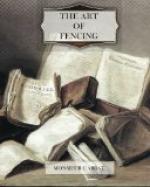Every Thrust must have it’s just Length, and carry with it a good Air, a regular Situation, Vigour, and a due Extension; See the 2d. plate.
Of recovering in Guard.
As soon as the Thrust is made, you must recover in Guard, which is done either by retiring out of Measure, or only to the Place from whence you, pushed; if out of Measure, ’tis done by springing back, or by bringing the Right Foot back behind the Left, and the Left behind the Right; and if to the Place from whence you pushed, you must parry if there’s a Thrust made; and if not, you must command the Feeble of the Adversary’s Sword, in order to cover the Side on which it is, without giving an Open on the other Side, which is done as you recover, by drawing back the Body on the Left Foot; which should bring with it the Right Knee, drawing the Foot, with the Heel a little raised from the Ground, to prevent any Accident that may happen by the Badness of the Terrace.
By this Recovery, commanding the Adversary’s Sword, you either get Light if he not stir, or Time if he does, which instead of being dangerous, as has formerly been thought, it is, by the Help of Art, become advantageous.
CHAP. IV.
Of the Parade of Quart.
To parry, signifies, in our Art, to cover when the Adversary pushes, that Part which he endeavors to offend; which is done it either by the Opposition of the Sword or of the Left Hand; but as I am now speaking of the Sword only, I must observe; that in order to parry well with it, you are to take notice of the Manner and Swiftness of your Adversary: By the Manner, is meant whether in Quart or Tierce; with his Fort to your Feeble, or with his Feeble to your Fort; and you are to observe the Swiftness of his Thrust, that you may regulate your Parade accordingly.
[Illustration: 3rd. Plate. Parade of Quart.]
[Illustration: Parade of Quart opposing with the hand.]
When a Thrust is made with the Fort to your Feeble, which is the best way; you must, by raising and turning the Hand a little in Quart, raise the Point, which brings it nearer to you, and hinders the Adversary from gaining your Feeble, which being raised up is too far from him, and makes it easy for you to seize his Feeble. (Refer to the 3d. Plate.)
If the Thrust be made on the Fort or Middle of your Sword, you need only turn the Hand a little in Quart.
If after the Adversary has pushed Quart, he pushes Seconde; you must parry with the Fort, bringing it nearer to you, and for the greater Safety, or to avoid other Thrusts, or the taking Time on your return, you must oppose with the left hand, which hinders him from hitting you as he meets your Thrust, and from parrying it, for want of having his Sword at Liberty. (Refer to the 7th Plate.)
The same Opposition may be made on a Lunge in Quart, and to be more safe in returning Thrust or Thrusts, you must close the Measure in parrying, which confounds the Enemy, who finds himself too near to have the Use of his Sword: Your Sword, in parrying, must carry it’s Point lower and more inward than in the other Parades.




